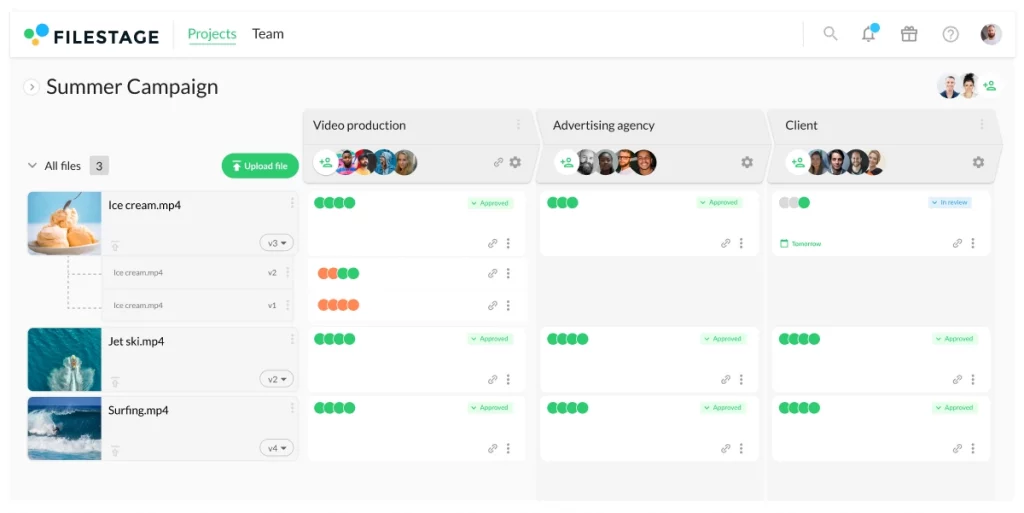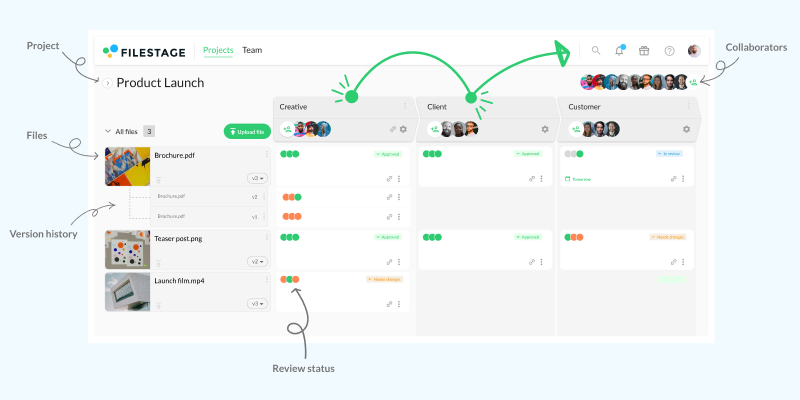Revisions and changes are inevitable parts of the creative process. As a project manager, it’s your job to collect feedback, interpret it, and make sure any proposed change requests are implemented correctly.
But various situations call for different types of change requests and ways of handling them.
That’s why, when starting your career in project management, you have to have a clear idea of what change requests are, types of requests you can use, and how to successfully write one.
So let’s dive in!
What is a project change request?
Change requests are essential parts of the creative process and a formal way of requesting various changes from your project team.
The change request process will vary depending on your (or your client’s) preferences. But for the sake of clarity, it’s important that you try to accurately define the change request process before the project begins.
That’s why you want to have a strong project change request process in place, to make sure your team produces their best work.
Download a free change request form template
Fill out the form below to get instant access to our change request form template.
To save an editable copy, follow these simple steps:
- Click “File” in the top-left corner
- Click “Make a copy”
- Choose your destination folder
Four different types of change requests in project management
Change requests come in all shapes and sizes. To give you a general idea about what to expect, here’s a closer look at four main types of change requests:
- Change request for major changes
- Change request for minor changes
- Change request for scheduled changes
- Change requests for spontaneous changes
1. Change request for major changes
From time to time, there will be a request that will significantly alter the course of your project. These requests may be made in response to unexpected changes or strategic shifts. It’s important to have a contingency plan in place so you can manage change requests effectively – especially the big ones!
2. Change request for minor changes
Your project will need the approval of various stakeholders. During the review and approval process, these stakeholders will often request a range of minor changes. It’s important that you accurately track and implement those changes.
3. Change request for scheduled changes
Your project timeline should include regular review rounds. These scheduled changes are predictable and manageable, so they’ll push the quality of the project as high as it can possibly go.
4. Change request for spontaneous changes
Depending on a range of factors (like the nature of your project or your stakeholder’s preferences), you may find requests for spontaneous changes.
Make sure that you keep these requests to a minimum, since they can disrupt your project timeline and demotivate your team members.
Five steps for building a standardized change request process
The change request process will vary from one project to the next. However, it’s very important for you to standardize it as much as possible. Then you can create a simple process that everyone can follow.
Without a standardized process, you’ll find that things will quickly become chaotic. For example:
- Stakeholders may be left out of the review process
- Change requests will be tracked in a non-uniform way
- Your team will struggle to accurately implement those changes
Here are five steps that you can use to build a standardized change request in project management for all your projects:
1. Collect and receive the change request
First and foremost, you’ll want to define the method you’ll use to collect change requests. You should act on this process in a predictable manner that helps your team carry out the best possible projects.
Here are all the factors you should consider at this point:
- The stakeholders you need to work with
- The length of time these stakeholders will have to make change requests
- The scope of change requests you can accept
- The tools you’ll use to collect change requests
In this situation, Filestage is a lifesaver. This digital proofing tool makes it easy for you to quickly and seamlessly collect in-context feedback from internal and external stakeholders.

2. Interpret the change request
Now that you’ve collected your changes, it’s time for you to sort through the change requests. As a marketing project manager, it’s your job to do an initial analysis of those change requests and start developing a strategy.
You’ll want to make sure you check change requests for a few factors, including:
- Viability: Are the changes realistic and in line with the project scope?
- Timing: Can those changes be completed in a reasonable timeframe (without impacting the overall quality of the project)?
- Consensus: Do some change requests conflict with one another? If so, which one should take precedence?
- Clarity: Are the change requests clear? Will your team be able to understand them as separate entities?
Again, Filestage can help with these four factors. In-context feedback is clear, and it helps eliminate the complexity and confusion that’s caused by endless email threads.

3. Distribute tasks
Now that you’ve gone through the change requests and developed your strategy, it’s time to pass those changes along to your team in the form of tasks.
The best project managers are able to retouch and repackage change requests that will make them clearer without affecting their meaning. This tactic helps each individual team member work efficiently and in line with the change request.
Let’s imagine a scenario where a stakeholder has requested that a wipe transition should be made faster. The marketing project manager will take that change request and translate it into technical, accurate language that the video engineer will understand.
4. Incorporate the changes
Now that your team has their tasks, it’s time for them to get to work. As the marketing project manager you’ll be responsible for addressing any questions or concerns. Plus, making sure that everything is going according to plan.
If you find that a change request was unclear at this stage, you’ll have to act as a go-between for your team members and stakeholders. Then you’ll need clear communication skills and a diplomatic approach to make sure both groups are satisfied.
5. Secure approval from stakeholders
Once the changes have been made, you’ll have to confirm that the edits were accurate. In other words, you’ll have to show the updated assets to all your stakeholders to get their final approval.
Filestage makes it easy to expedite the review process, and make sure that no one misses a critical change request.

Five tips for handling change requests like a boss
Now that we have a better idea of what the change request process will look like, here are some tips for helping you take control of the change request process.
1. Acknowledge change requests
All too often, project managers fail to communicate with their stakeholders after they’ve received their change requests. This happens either because they forget or a wish to go through the change requests before they communicate their feedback.
But, it’s critical for you to properly communicate to all your stakeholders that you received their requests.
Here are three main reasons why you should never skip communicating with your stakeholders about receiving their change requests:
- A lack of communication at this stage can put the client on edge and harm an otherwise warm relationship.
- A lack of discourse about the change requests may mean that key questions and talking points are missed.
- A lack of an explicit confirmation could be considered rude, so it’s important for marketing project managers to act quickly.
You should be sure to keep your stakeholders updated as much as possible. Before assuring them of the next steps you’ll take to move the project forward, thank them for their constructive and insightful change requests.
2. Don’t take requests personally
Marketing project managers oversee the creation of some truly wonderful projects and it’s completely normal for you and your team to feel proud of the work you’ve created.
Receiving a scathing change request can often be disheartening. If somebody finds a flaw in something you love, it’s only natural for you to have difficulty processing that piece of constructive criticism. But you should make every effort to avoid taking change requests personally.
Before going through change requests, remind yourself that everyone wants the project to be the best it can be. Also, remember that people have different communication styles. If a piece of feedback sounds harsh, it’s rare for there to be any ill intent behind it.
3. Follow up on any doubts
It’s absolutely critical for you to follow up on any doubts you have. Perhaps you received an unclear change request, but passed it along to your team anyway. As benign as it may look, this can quickly turn the project into chaos.
That’s why it’s very important for you to prevent this scenario from occurring. It’s better to double check with your stakeholders than eventually make an error.
4. Protect your team
Your team should feel happy and confident while working. Being a project manager, you have a role of mediating between your team and stakeholders. It’s a tiring job, and it requires a lot of tact and great communication skills.
But if you receive a harsh change request, you should try to absorb its message and repackage it for your team. Ultimately, all feedback should be constructive, and your team has to know their work is highly valued.
5. Help your team stay focused
Change requests can often be disruptive and disappointing. So when it comes to these requests, it’s essential for your project scope to outline a clear strategy.
For example, let’s imagine that your graphic designer is hard at work on some wireframes for an exciting new project. If they’re in the zone and producing excellent work, you won’t want to dishearten them with a small change request for another project.
This tactic keeps your team focused on the task at hand and working hard to produce the best work they can. That’s why it’s important to interpret and distribute change requests in a constructive way that helps your team keep moving forward.
Final thoughts
Project change requests don’t have to be disruptive. If you’re prepared with the right project change process, you can seamlessly integrate change requests into your workflow and lead your team to success.If you’re looking for a tool that will help you make your change request process in project management as painless as possible, check out Filestage and start a free trial →

